If I had to pick one meal that could give you a taste of who I am and where I come from it is undeniably this slow-cooked Tomato Ragu. It is a part of my childhood, part of my family legacy, it practically oozes through my veins. This year, as an ambassador for Taste of Harmony (14 – 25 March), which embraces our cultural diversity through food, I wanted to share not only a recipe I know you will love but let it tell you its story.

I was never actually ‘taught’ how to cook this sauce that dressed the pasta we ate most weeknights. It is just something I seem to know how to do. Inadvertently, unconsciously learned, I suspect, from afternoons watching my grandmother in her kitchen. I can vividly recall her standing at her green Meters stove wearing her signature floral pinafore apron over her housedress (she never wore pants) making this sauce in the very same orange Bessemer pot that I cherish and stir my ingredients in today.
Memory and aroma have always been my guide, the pungent sweetness of onion and garlic, the grassy hit of dried oregano, the sizzle and spit of peppery olive oil as the lamb chars and caramelizes in the pan before adding in the pureed tomatoes (passata). What makes this so good is simple ingredients cooking long and slow. The sauce is rich, the slow cooking of the lamb, unctuous and sweet, adds meaty flavour to the heady mix of tomatoes laced with garlic and herbs. It’s so simple, yet so so good. Like a Little Black Dress it goes with anything, pasta, gnocchi, risotto, meatballs, use it to make a lasagne, eggplant parmigiana, pasta bake, or just sit down with a hunk of bread and greedily dip and eat (tip – a good way to check if the seasoning is right as you cook – chef’s treat!). It’s a foundation recipe that once you know how to cook it well will serve you a lifetime of delicious meals.
Until I decided to share this recipe, I had no idea of the exact quantities of ingredients. Like all of my grandmother’s cooking, this is the food that her mother and grandmother would have made for their families by eye, by smell, by pure instinct. The food she cooked thousands of miles away for her own family that made her think of home.
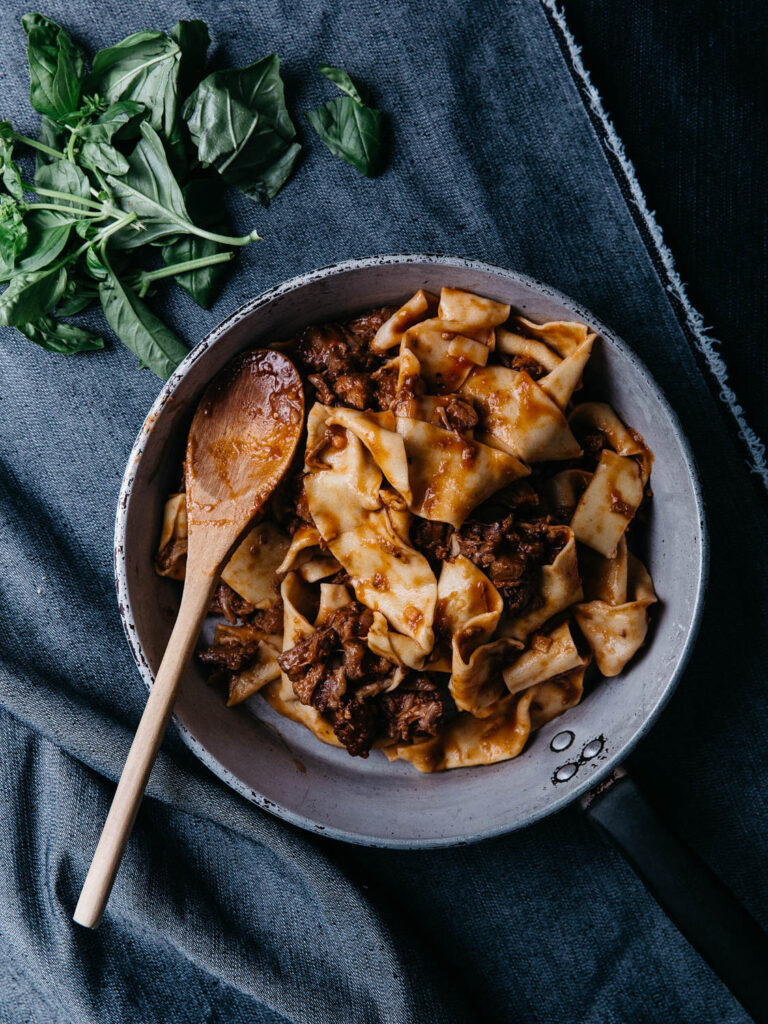
My grandparents are from the sun-baked Italian province of Calabria situated on the toe of the Italian ‘boot’. They grew up in small rural towns where life was hard, poverty was common, and the only way to survive was to live off the land. They grew wheat to make flour, olives to make oil, grapes for making wine, even flax plants to make linen. Cows and goats produced milk that was turned into cheese, chickens gave them eggs, and pigs were fattened to make sausages that were hung and dried to eat throughout the year. Fruit, vegetables, nuts, pretty much anything that could be grown they grew and either consumed, preserved or sold to make ends meet.
During the cold winters when the garden barely produced a few beans, it was the stash of preserves from the summer harvest that fed families. Frutti d’estate tesoro del inverno. Fruits of summer become winter’s treasure. Eggplants were pickled, chillies dried, stone fruit steeped in syrup, olives marinated, everything grown turned into a delicacy we now pay a premium to buy at artisan shops labelled ‘gourmet’. But it was the fields of plump Roma tomatoes that were fundamental to family meals. Replanted from their own seeds year after year and harvested when fully ripened by the sun, they were cooked, peeled, and sieved into jars as passata, tomato puree, to make my family’s tomato sauce.
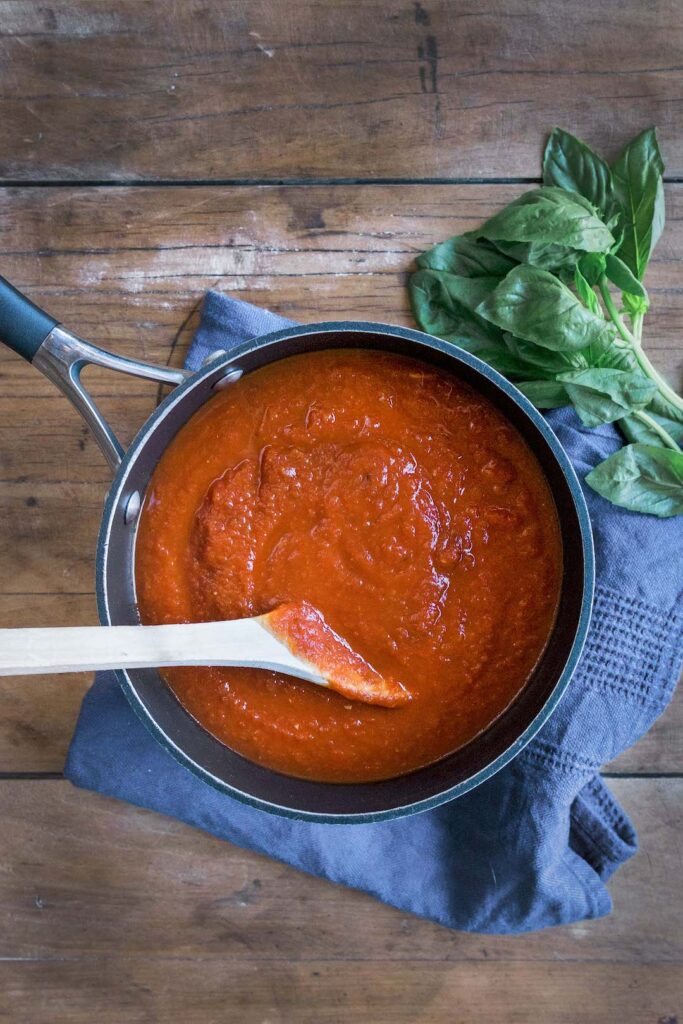
Italian migration to Australia was prolific after the second World War. My grandparents and two young children (one of them my mother) were four of the 42,000 Italians who left their homeland behind and set sail for a new life in Australia where migrants were welcome due to industrialisation. They moved to a small farming community in Western Australia’s South West, where friends, paesani, from their village in Calabria had settled. This small community of Italians supported each other as they started new lives from scratch in a foreign world.
My grandfather was away for long periods at a time laying railway tracks while my grandmother pined for her beloved Italy and the family she thought she would never see again while she adapted to a foreign world. She was illiterate and only learned smatterings of English once her children attended school. My mother, the eldest, could not speak English and would get punished by the teachers if she spoke her native tongue. It is why my mother refused to teach me Italian, and barely spoke Italian in the house. She wanted me to be articulate and intelligent, and based on her experience, in her mind, that meant I should only speak English. Subsequently, I grew up without being able to fully communicate with my grandparents. Without being able to listen to all their stories, to hear first-hand how they adapted to a new life in Australia. The hardships, the joys, the memories from home. These are conversations and stories I will never have the opportunity to hear.
My mother was six years old when she first made tomato sauce. My grandfather taught her, as my grandmother was often in hospital with illness or complications with childbirth; she buried three babies without understanding why they died. I imagine my mother, the eldest of six, standing on a chair so she could reach the stovetop, stirring the pot as the onion and garlic sizzled in the pan. My grandfather knew that if she could make sauce, when he returned from work all that had to be done was boil some pasta, and dinner was done. They could always count on tomato sauce because there was always a supply of homemade passata in the cupboard.
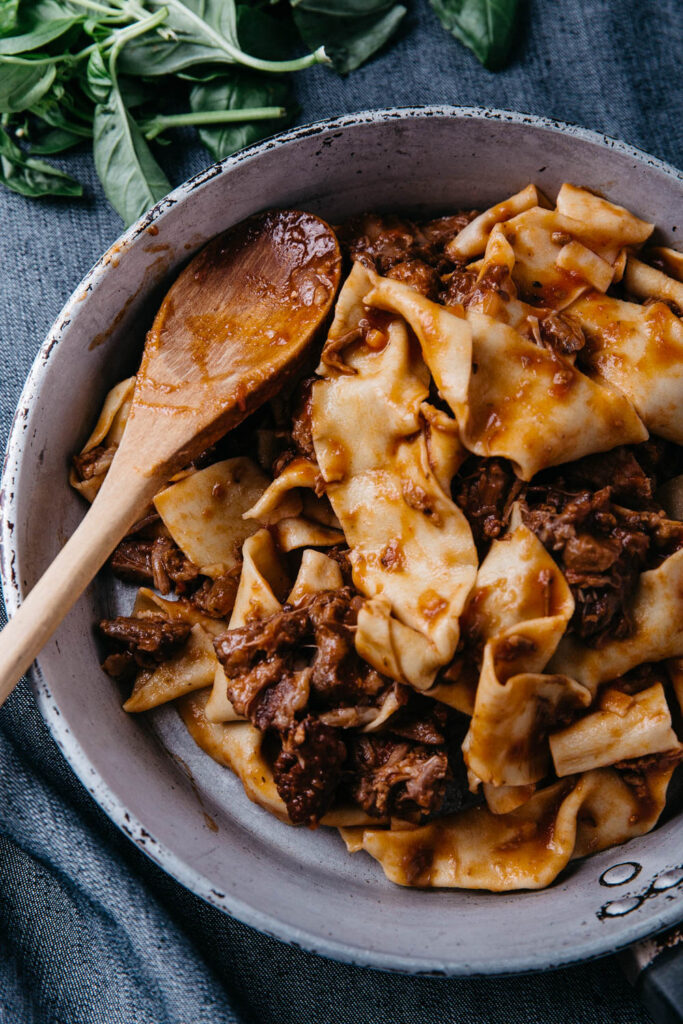
My grandparents painstakingly grew their tomatoes from seeds. Some four hundred vines first planted from tomato seeds from Italy my grandmother tucked into her bra when she left for Australia. Those seeds took root in their new home, thousands of them hand-picked and turned into passata every year to recreate my grandmother’s slow-cooked tomato ragu. The sauce I remember my mother cooking every day.
Every afternoon at three o’clock my mother would begin making her tomato sauce. She would sweat the vegetables in olive oil, brown the meat, then open up one of the beer bottles from the back shed and pour in a smooth stream of homemade passata. We stored our passata in king brown beer bottles that my father would collect from a year’s worth of hard-earned afternoon brews (he never complained about this duty).

One weekend every summer, our backyard would be bursting with the heady scent of earthy, over-ripe tomatoes piled in boxes, skins stretched with hair-line cracks threatening to explode their pulpy sweet flesh. It was always swelteringly hot, because that’s when tomatoes are at their prime, and my whole big fat Italian family would come over with enough food to stop famine in Africa. Grandparents, aunts, uncles, cousins, all of them would be there, talking and laughing and boiling and skinning and pureeing until we had enough passata to last us for a whole year. At least 365 bottles so my father could have his nightly fix. It was loud, with everyone talking at once as they shooed the millions of flies that were drawn to the intoxicating combination of juice and sweat.
I can remember going through a teenage stage when I rebelled against my Italian roots, wanting to fit in with my Anglo Australian world, and hid in my room listening to Duran Duran while the dreaded Tomato Day, perfectly penned ‘International Wog Day’ in Melina Marchetta’s novel Looking for Alibrandi was going on. I look back on those family days now, and all those traditions and customs that prevailed through our generations, and feel so lucky to have been a part of it all. To be carrying on my family traditions today. My grandmother’s recipes, the food my mother cooked, the meals we shared together with family, tell me who I am. They are my identity. Every culture, every family, has their own, and our food can tell our stories, bring back memories and nurture all at the same time.
My grandmother passed away at 97 years of age. I can still hear her saying “mangia, eat, you too skinny!” I think if I put on 20kg she still would have said that! Feeding her family was who she was, her purpose in life. I proudly cook the meals she made now for my family, they bring me comfort and pride (and I am guilty of overfeeding too – Nonna would be proud!). But it is the slow-cooked tomato ragu clinging to a heaping pile of pasta that connects me to her, takes me back to my mother’s kitchen, brings back the memory of my father’s voice, and will live on in my children’s memories while filling what seems to be bottomless stomachs.
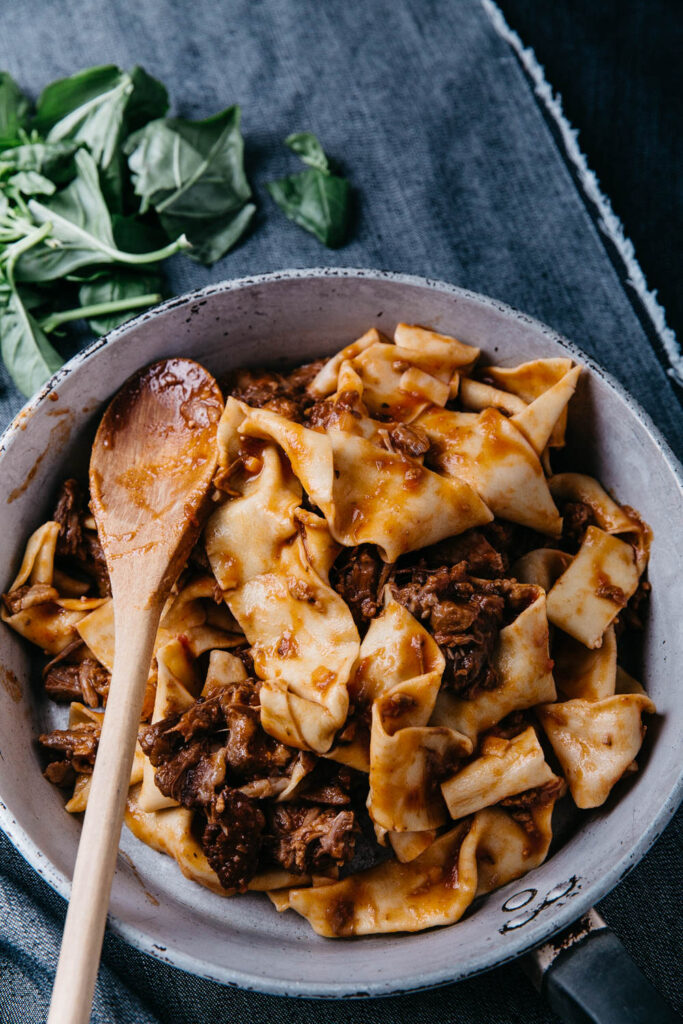
My grandmother usually served her ragu with her homemade meatballs (a recipe for another day), and would leave the lamb pieces whole so it could be served separately and sucked off the bones. I like to shred the meat and add it back to the sauce so it can be eaten (like I liked to eat it as a child) with each forkful of pasta (or could also be because I have always had an aversion to hearing those lip-smacking sounds that makes me shudder to my core).
More often than not, I add store-bought passata because those big family Tomato Days just don’t happen often these days. Times change. But that’s ok. Store-bought gives just as good a result because, at the end of the day, this recipe is all about the love and time you give to the ingredients.

So if you make this meal for your family, follow the recipe, but maybe the next time you try doing what Nonna did, use your senses to guide you. Don’t be afraid to taste it along the way. The amount of meat is a guide, use a little less or more to suit, and feel free to use another cut, such as shoulder, just make sure it’s on the bone for maximum flavour. Any robust pasta works here, rigatoni, penne, pappardelle (pictured), fettuccine or plain ol spaghetti.
Meals shared are stories shared. I encourage you to make those family recipes, don’t let them die out with our grandparents. There’s something about those old recipes that bring comfort, and keep memories and stories alive.
If you need an excuse, register for Taste of Harmony 14 – 25 March, and get together with family or friends to share your family’s stories, or your cultural story, through the deliciousness of food.
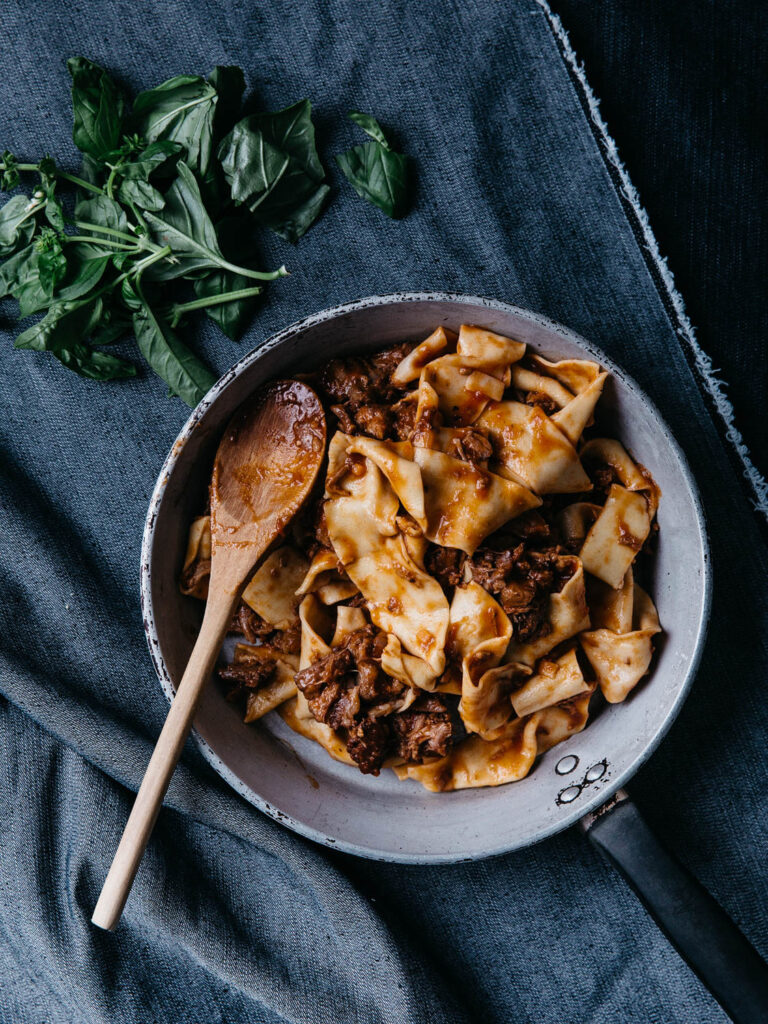
Best Ever Slow-Cooked Tomato Ragu
Ingredients
Olive oil
3 – 4 lamb shanks (roughly 1.5 – 2kg)
Salt
2 1/2 tbsp dried oregano
1 onion, peeled and finely chopped
1 celery stick, finely chopped
3 cloves garlic, peeled and finely sliced
3 litres Tomato Passata (see note)
handful fresh basil leaves
Method
Slosh a good glug of olive oil in a large, heavy-based pot, and heat on medium-high.
Add the lamb and sprinkle generously with salt and 1 x tbsp of the oregano. Brown on all sides, adding extra olive oil if the pot becomes dry. Take your time here, the browned bits are where all the flavour lies. Once nice and golden brown, remove and set aside.
Splash a little more olive oil in the pan and add the onion and celery. Saute over medium heat, stirring to dislodge any brown bits from the pan as you do. Once translucent, add the garlic and stir for another minute, or until fragrant.
Increase the heat to high, return the meat to the pan and stir to combine.
Pour in the tomato passata, add a good sprinkle of salt and the remaining oregano and stir until mixture comes to a boil.
Add the basil leaves, cover with a lid, reduce heat to low and simmer for at least 2 1/2 hours. The longer and slower the sauce cooks, the better it will be. Check every now and then and give it a stir once or twice. You’re looking for the meat to be falling off the bone and the sauce to be rich red in colour, with some oil slicked to the top. Taste and add salt if necessary.
Remove the meat from the pot and increase heat to medium-high and bring back to a slow boil while you shred the meat and any fat from the bones.
Return the shredded meat to the pot and cook for 30 minutes, or until sauce is thickened.
Cook your chosen pasta in boiling salted water. (The sauce will coat a 500gm packet of pasta easily with some reserves depending on how much sauce you like on your pasta. 100g pasta feeds one person, so cook as much as you need and save any extra sauce for another day)
Drain the al dente pasta and return it to the empty pot you cooked it in. Ladle over enough sauce to coat and toss to combine. Serve into individual plates topped with the desired amount of extra sauce, or alternatively, serve in one big bowl topped with a little sauce and a bowlful of extra sauce so everyone can add as much as they need. Offer parmesan cheese and chilli and fresh crusty bread.
Any leftover sauce keeps for five days in the refrigerator or three months in the freezer.
Serves 6
Note: Passata is easy to find at any supermarket or grocer. They generally come in bottles ranging from 400gm to 700gm (or more if you buy in bulk). Don’t get too caught up in exact measurements – add in as close the specified amount as possible, ensuring the meat is covered.

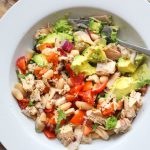

Oh This was such a great heart felt family story. Thank you for sharing. I cant wait to cook. My mouth is watering as I type. Thank you 🙂
Thanks Cozzy. Hope all is well!